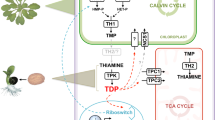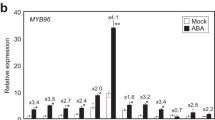Abstract
The expression of a number of plant genes is regulated by an endogenous circadian clock. We report that the Arabidopsis NIA2 (nitrate reductase) gene shows robust circadian oscillations in mRNA accumulation which persist for at least 5 days in plants that have been grown in a light-dark (LD) cycle and then transferred to continuous light (LL). We further show that NIA2 mRNA accumulation oscillates in a circadian fashion in plants that have been grown in LD and then transferred to continuous darkness (DD). Results from nuclear run-on transcriptional analysis suggest that the oscillations in steady-state levels of NIA2 mRNA abundance are not primarily due to changes in transcription but, instead, reflect post-transcriptional regulation. The circadian oscillations in NIA2 mRNA abundance are paralleled by circadian oscillations in nitrate reductase enzyme activity (NR activity) in Arabidopsis plants that have been grown in LD and then transferred either to DD or to LL. Etiolated Arabidopsis seedlings express neither NIA2 mRNA nor NR activity. However, both NIA2 mRNA accumulation and NR activity are induced by exposure to white light. The inductive effects of light on NIA2 mRNA accumulation are due, at least in part, to a very low fluence phytochrome-mediated response. However, the persistence of circadian oscillations in NIA2 mRNA abundance for at least 5 days in LL demonstrates that the circadian clock is capable of overriding or gating the inductive effects of light on NIA2 mRNA accumulation in Arabidopsis for an extended, continuous period of time.
Similar content being viewed by others
References
Adamska I, Scheel B, Kloppstech K: Circadian oscillations of nuclear-encoded chloroplast proteins in pea (Pisum sativum). Plant Mol Biol 17: 1055–1065 (1991).
Ausubel FM, Brent R, Kingston RE, Moore DD, Seidman JG, Smith JA, Struhl K: Current Protocols in Molecular Biology. Greene Publishing Associates/Wiley Interscience, New York (1987).
Beale SI, Weinstein JD: Tetrapyrrole metabolism in photosynthetic organisms. In: Dailey HA (ed) Biosynthesis of Heme and Chlorophylls, pp. 287–391. McGraw-Hill, New York (1990).
Becker TW, Foyer C, Caboche M: Light-regulated expression of the nitrate-reductase and nitrite-reductase genes in tomato and in the phytochrome-deficient area mutant of tomato. Planta 188: 39–47 (1992).
Börner T, Mendel RR, Schiemenn J: Nitrate reductase is not accumulated in chloroplast-ribosome-deficient mutants of higher plants. Planta 169: 202–207 (1986).
Bowsher CG, Long DM, Oaks A, Rothstein SJ: Effect of light/dark cycles on expression of nitrate assimilatory genes in maize shoots and roots. Plant Physiol 95: 281–285 (1991).
Braaksma FJ, Feenstra WJ: Isolation and characterization of nutrate redyctase-deficient mutants of Arabidopsis thaliana. Theor Appl Genet 64: 83–90 (1982).
Brusslan JA, Tobin EM: Light-independent developmental regulation of cab gene expression in Arabidopsis thaliana seedlings. Proc Natl Acad Sci USA 89: 7791–7795 (1992).
Caboche M, Rouzé P: Nitrate reductase: a target for molecular and cellular studies in higher plants. Trends Genet 6: 187–192 (1990).
Campbell WH: Nitrate reductase and its role in nitrate assimilation in plants. Physiol Plant 74: 214–219 (1988).
Caspar T, Quail PH: Promoter and leader regions involved in the expression of the Arabidopsis ferredoxin A gene. Plant J 3: 161–174 (1993).
Cheng C-L, Acedo GN, Cristinsin M, Conkling MA: Sucrose mimics the light induction of Arabidopsis nitrate reductase gene transcription. Proc Natl Acad Sci USA 89: 1861–1864 (1992).
Cheng C-L, Acedo GN, Dewdney J, Goodman HM, Conking MA: Differential expression of the two Arabidopsis nitrate reductase genes. Plant Physiol 96: 275–279 (1991).
Cheng C-L, Dewdney J, Nam H-G, den Boer BGW, Goodman HM: A new locus (NIA1) in Arabidopsis thaliana encoding nitrate reductase. EMBO J 7: 3309–3314 (1988).
Cohen AS, Cumming BG: Endogenous rhythmic activity of nitrate reductase in a selection of Chenopodium rubrum. Can J Bot 52: 2351–2360 (1974).
Crawford NM, Campbell WH: Fertile fields. Plant Cell 2: 829–835 (1990).
Crawford NM, Campbell WH, Davis RW: Nitrate reductase from squash: cDNA cloning and nitrate regulation. Proc Natl Acad Sci USA 83: 8073–8076 (1986).
Crawford NM, Smith M, Bellissimo D, Davis RW: Sequence and nitrate regulation of the Arabidopsis thaliana mRNA encoding nitrate reductase, a metalloflavoprotein with three functional domains. Proc Natl Acad Sci USA 85: 5006–5010 (1988).
Deng M-D, Faure J-D, Caboche M: The molecular aspects of nitrate and nitrite reductase expression in higher plants. In: Verma DPS (ed) Control of Plant Gene Expression, pp. 425–441. CRC Press, Boca Raton, FL (1993).
Deng M-D, Moureaux T, Leydecker M-T, Caboche M: Nitrate-reductase expression is under the control of a circadian rhythm and is light inducible in Nicotiana tabacum leaves. Planta 180: 257–261 (1990).
Deng X-W, Gruissem W: Control of plastid gene expression during development: the limited role of transcriptional regulation. Cell 49: 379–387 (1987).
Feinbaum RL, Ausubel FM: Transcriptional regulation of the Arabidopsis thaliana chalcone synthase gene. Mol Cell Biol 8: 1985–1992 (1988).
Feinberg AP, Vogelstein B: A technique for radiolabelling DNA restriction endonuclease fragments to high specific activity. Anal Biochem 137: 266–267 (1984).
Galangau F, Daniel-Vedele F, Moureaux T, Dorbe M-F, Leydecker M-T, Caboche M: Expression of leaf nitrate reductase genes from tomato and tobacco in relation to light-dark regimes and nitrate supply. Plant Physiol 88: 383–388 (1988).
Giuliano G, Hoffman NE, Ko K, Scolnik PA, Cashmore AR: A light-entrained circadian clock controls transcription of several plant genes. EMBO J 7: 3635–3642 (1988).
Gowri G, Campbell WH: cDNA clones for corn leaf NADH: nitrate reductase and chloroplast NAD(P)+: glyceraldehyde-3-phosphate dehydrogenase. Plant Physiol 90: 792–798 (1989).
Heimer YM, Filner P: Regulation of the nitrate assimilation pathway in cultured tobacco cells. Biochim Biophys Acta 230: 362–372 (1971).
Hoff T, Stummann BM, Henningsen KW: Structure, function and regulation of nitrate reductase in higher plants. Physiol Plant 84: 616–624 (1992).
Huber JL, Huber SC, Camphell WH, Redinbaugh MG: Reversible light-dark modulation of spinach leaf nitrate reductase activity involves protein phosphorylation. Arch Biochem Biophys 296: 58–65 (1992).
Kaufman LS, Briggs WR, Thompson WF: Phytochrome control of specific mRNA levels in developing pea buds. Plant Physiol 78: 388–393 (1985).
Kay SA, Millar AJ: Circadian-regulated cab gene transcription in higher plants. In: Young MW (ed) The Molecular Genetics of Biological Rhythms, pp. 73–89, Marcel Dekker, New York (1993).
Kay SA, Nagatani A, Keith B, Deak M, Furuya M, Chua N-H: Rice phytochrome is biologically active in transgenic tobacco. Plant Cell 1: 775–782 (1989).
Kubasek WL, Shirley BW, McKillop A, Goodman HM, Briggs W, Ausubel FM: Regulation of flavonoid biosynthetic genes in germinating Arabidopsis seedlings. Plant Cell 4: 1229–1236 (1992).
LaBrie ST, Wilkinson JQ, Crawford NM: Effect of chlorate treatment on nitrate reductase and nitrite reductase gene expression in Arabidopsis thaliana. Plant Physiol 97: 873–879 (1991).
Leutwiler LS, Meyerowitz EM, Tobin EM: Structure and expression of three light-harvesting chlorophyll a/b-binding protein genes in Arabidopsis thaliana. Nucl Acids Res 14: 4051–4064 (1986).
Lillo C: Circadian rhythmicity of nitrate reductase activity in barley leaves. Physiol Plant 61: 219–223 (1984).
Lissemore J, Colbert J, Quail P: Cloning of cDNA for phytochrome from etiolated Cucurbita and coordinate photoregulation of the abundance of two distinct phytochrome transcripts. Plant Mol Biol 8: 485–496 (1987).
Ludwig SR, Oppenheimer DG, Silflow CD, Snustad DP: Characterization of the α-tubulin gene family of Arabidopsis thaliana. Proc Natl Acad Sci USA 84: 5833–5837 (1987).
McClung CR: The higher plant, Arabidopsis thaliana, as a model system for the molecular analysis of circadian rhythms. In: Young M (ed) The Molecular Genetics of Biological Rhythms, pp. 1–35. Marcel Dekker, New York (1993).
Melzer JM, Kleinhofs A, Warner RL: Nitrate reductase regulation: effects of nitrate and light on nitrate reductase mRNA accumulation. Mol Gen Genet 217: 341–346 (1989).
Millar AJ, Kay SA: Circadian control of cab gene transcription and mRNA accumulation in Arabidopsis. Plant Cell 3: 541–550 (1991).
Nagy F, Kay SA, Chua N-H: A circadian clock regulates transcription of the wheat Cab-1 gene. Genes Devel 2: 376–382 (1988).
Oelmüller R, Levitan I, Bergfeld R, Rajasekhar VK, Mohr H: Expression of nuclear genes as affected by treatments acting on the plastids. Planta 168: 482–492 (1986).
Olesiak W, Ungar A, Johnson CH, Hastings JW: Are protein synthesis inhibition and phase shifting of the circadian clock in Gonyaulax correlated?. J Biol Rhyth 2: 121–138 (1987).
Otto B, Grimm B, Otterbach P, Koppstech K: Cireadian control of the accumulation of mRNAs for light- and heat-inducible chloroplast proteins in pea (Pisum sativum L.). Plant Physiol 88: 21–25 (1988).
Pelgrim ML, McClung CR: Differential involvement of the circadian clock in the expression of genes required for ribulose-1,5-bisphosphate carboxylase/oxygenase synthesis, assembly, and activation in Arabidopsis thaliana. Plant Physiol, in press (1993).
Rajasekhar VK, Gowri G, Campbell WH: Phytochrome-mediated light regulation of nitrate reductase expression in squash cotyledons. Plant Physiol 88: 242–244 (1988).
Rajasekhar VK, Mohr H: Appearance of nitrite reductase in cotyledons of the mustard (Sinapsis alba L.) seedling as affected by nitrate, phytochrome and photooxidative damage of plastids. Planta 168: 369–376 (1986).
Redinbaugh MG, Sabre M, Scandalios JG: Expression of the maize Cat3 catalase gene is under the influence of a circadian rhythm. Proc Natl Acad Sci USA 87: 6853–6857 (1990).
Richards EJ, Ausubel FM: Isolation of a higher eukaryotic telomere from Arabidopsis thaliana. Cell 53: 127–136 (1988).
Shah DM, Hightower RC, Meagher RB: Complete nucleotide sequence of a soybean actin gene. Proc Natl Acad Sci USA 79: 1022–1026 (1982).
Shiraishi N, Sato T, Ogura N, Nakagawa H: Control by glutamine of the synthesis of nitrate reductase in cultured spinach cells. Plant Cell Physiol 33: 727–731 (1992).
Sweeney BM: Rhythmic Phenomena in Plants. Academic Press, New York (1987).
Vaucheret H, Marion-Poll A, Meyer C, Faure J-D, Marin E, Caboche M: Interest in and limits to the utilization of reporter genes for the analysis of transcriptional regulation of nitrate reductase. Mol Gen Genet 235: 259–268 (1992).
Vincentz M, Caboche M: Constitutive expression of nitrate reductase allows normal growth and development of Nicotiana plumbaginifolia plants. EMBO J 10: 1027–1035 (1991).
Vincentz M, Moureaux T, Leydecker MT, Vaucheret H, Caboche M: Regulation of nitrate and nitrite reductase expression in Nicotiana plumbaginifolia leaves by nitrogen and carbon metabolites. Plant J 3: 315–324 (1993).
Wang Z, Feldmann KA, Scholl RL: A chloratehypersensitive, high nitrate/chlorate uptake mutant of Arabidopsis thaliana. Physiol Plant 73: 305–310 (1988).
Wilkinson JQ, Crawford NM: Identification of the Arabidopsis CHL3 gene as the nitrate reductase structural gene NIA2. Plant Cell 3: 461–471 (1991).
Zerr DM, Hall JC, Rosbach M, Siwicki KK: Circadian fluctuations of period protein immunoreactivity in the CNS and the visual system of Drosophila. J Neurosci 10: 2749–2762 (1990).
Author information
Authors and Affiliations
Rights and permissions
About this article
Cite this article
Pilgrim, M.L., Caspar, T., Quail, P.H. et al. Circadian and light-regulated expression of nitrate reductase in Arabidopsis . Plant Mol Biol 23, 349–364 (1993). https://doi.org/10.1007/BF00029010
Received:
Accepted:
Issue Date:
DOI: https://doi.org/10.1007/BF00029010




